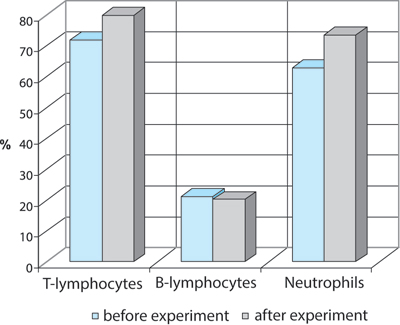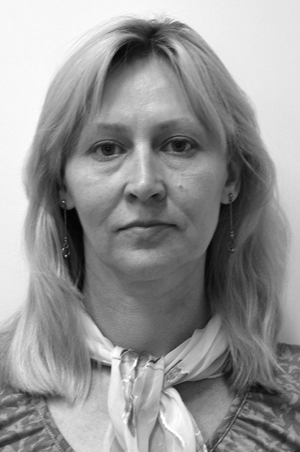IMMUNE STATUS OPTIMIZATION BY MEANS OF PHYSICAL TRAINING
Фотографии:
ˑ:
V.N. Kolyasova, Ph.D.
R.R. Kolyasov, associate professor, Ph.D.
Kazan (Volga region) federal university, Kazan
Key words: recreational physical culture, immunoregulatory center stimulation.
Introduction. The issue of development and use of the methodologies of motor activity that can enhance the body's immune status is still relevant. Methodology is a system of means to achieve a specific result during physical education. The methods are the ways of using physical exercises.
The main function of immunity is to protect the body from the genetically foreign (bacteria, viruses, toxins, proteins, etc.) [1]. The body's response to physical load, as to a microinjury, is stress and inflammatory, stimulating immune processes. Herewith, recovery and regeneration are not only local, but general, resulting in development of the structural basics and functional mechanisms of the long-term adaptation [3, 5].
The purpose of the study was to determine the influence of special means and methods of motor activity on the immune system.
Organization and methods. The studies were organized in the form of an ascertaining experiment with the group of students (15 persons) from the special university department. A special set of physical exercises in the form of articular gymnastics combined with autogenic training has been used for a month.
The set was aimed at stimulation of immunomodulatory processes in the body.
The objectives of the set of exercise are:
1) affecting with exercises on the central and peripheral organs of the immune system, psychoimmunoprophylaxis;
2) increase of mobility in joints;
3) forming the need for systematic physical exercises.
The mechanisms of recreational action of physical exercises are: trophic and compensatory.
The methodical features of the set of exercises:
1. Joints are affected in the following sequence: from distal to proximal joints of upper limbs; from distal to proximal joints of lower limbs. The impact on joints of the spine is made in the craniocaudal direction, joints of the cervical spine; thoracic spinal joints; retrosternal and vertebrocostal articulations; thoracicoinferior spine; lumbar joints and sacroiliac articulations.
2. Exercises (motions) occur both in the orthogonal and diagonal directions to excite more proprioceptors, without increasing the power (intensity) of the load.
3. Balancing and strengthening exercises are used for stabilizing muscles (foot muscles, suboccipital muscles, oculomotor muscles, etc.) and paravertebral muscles of postural (static, postural) centers of the spine.
4. When mobilizing the spinal column in locomotor (mobile) centers one is to restore the maximum possible mobility in the following spinal motion segments: occipital bone - Оо, С1-2 (craniocervical locomotor center); С6-7, D1-3 (cervicothoracic locomotor center); D8-12, L1-2 (thoracolumbar locomotor center); L5, S1 (lumboacral locomotor center).
5. The effects on the musculoskeletal system are combined with an isometric (static) load to stimulate prostaglandin production.
6. Using breathing exercises focused on inspiration (in duration and depth) to activate the lymphoid tissue associated with the bronchi and lungs, as well as increased lymphokinesis. Teaching different types of breathing, distinguished by the activity of departments of the breathing apparatus: upper (breathing at 1st-2nd ribs), medium (breathing at the level of the 3-4-5th ribs), inferoposterior (breathing at the level of asternal ribs).
7. The total capacity of the applied load is moderate or high. The load intensity is not more than 80 % of the individual cardiac reserve (average HR = 134-160 bpm).
8. Autogenous training is applied in the final part. In addition to the task of post-exercise recovery, autotraining is used to lower the threshold of the activation of stress-limiting systems [2].
9. The contraindications for articular gymnastics (early post-traumatic period, instability of vertebral-motor segments, acute period of osteochondrosis, osteoporosis and other diseases of the spine and joints) are taken into account.
Note. These methodological features are universal and should be followed when using various forms and means of physical training.
Close interaction of basic cellular partners of T-lymphocytes, B-lymphocytes and macrophages, providing the whole range of humoral and cellular immune responses, underlied the immunological reactions. The immune status was investigated by estimating the immunological reaction, which was called "lymphocyte-macrophage cooperation". Cellular factors of specific immunity were assessed by the relative T-lymphocytes + 0-lymphocytes count. The state of the humoral part of specific immunity – according to the relative B-lymphocytes count in the blood. The function of cellular nonspecific immunity - by the phagocytic activity of peripheral blood neutrophils in the digestion phase. Blood test was made at the beginning and at the end of the ascertaining experiment.
Results, discussion and conclusions. The changes in the indicators of specific and nonspecific immunity during the study are shown in Fig.

Fig. Changes in relative indicators of T-lymphocytes, B-lymphocytes, phagocytic activity of neutrophils in students
The stimulation of immunoregulatory centers using physical exercises has enhanced the neutrophil phagocytic activity by the increment of the phagocytosis per cent at the digesting phase. At the beginning of the ascertaining experiment this percentage was 62,8±2,5%, at the end - 73,5±2,7%, i.e. the nonspecific resistance of the body was enhanced. The values of phagocytic activity of neutrophils during the digestion phase increased by 17.0%. Intense stimulation of general protection factors in the form of the activated neutrophil phagocytic response ensures reliable virus protection and utilization of toxic metabolic wastes.
The simultaneously graduated physical load can intensify the mechanisms of specific immunity. Due to the interdependence of various elements of the immune system physical effects inevitably provoke numerous complex sequential changes in this system (the principle of connected regulatory blocks). B-lymphocytes are highly resistant to physical load at the beginning of the effects the relative number of B-lymphocytes was 21,2 ± 1,5%, at the end - 20,2 ± 1,3%. The values of the relative number of B-lymphocytes have only a slight tendency to reduce - by -4.72 %, but are statistically significant, though individual variations of expression of the humoral specific immunity are significant.
The changes in the production of the relative number of T-lymphocytes from 71,8 ± 3,4 to 79,8 ± 2,9% characterizes the cellular immune response to physical activity and aims to strengthen the processes of inflammation due to damaged ligament and muscle tissue. The increase in the absolute indices of T-lymphocytes from 3,734 to 4,150 thousand/ml indicates the differentiation that has occurred in 0-lymphocytes. The values of the relative number of T-lymphocytes have increased by 11.1%.
In addition, it should be noted that the subjects’ indices of white blood cell concentration ranged from 4.0 to 7.0 x 109/l; clear lymphocyte circles were detected when allocating the total white blood cell population; single 2-nuclear cells were marked when calculating T-lymphocytes, indicating their moderate proliferation.
The stimulation of immunoregulatory effects on the body of students of special medical groups using special forms, means and methods of motor activity in the experiment had a positive effect. Thus, we can conclude that the indices of the immune status of the students’ body were in the phases of activation and compensation at the end of the experiment (according to R.S. Suzdal'nitskiy and V.A. Levando, 2003) [4].
References
- Cassil, G.N. Body’s internal environment / G.N. Cassil. – Moscow: Nauka, 1983. – 225 P. (In Russian)
- Korneva, E.A. Stress and psychoneuroimmunology / E.A. Korneva // Stress and immunity: Proceedings of the All-Union conf. – 1989. – P. 26-27. (In Russian)
- Malyshev, V.V. The interrelationship between inflammation and stress reaction – the integral biological component of an optimal inflammatory process / V.V. Malyshev, L.S. Vasil’eva, V.V. Kuz’menko // Uspekhi sovremennoy biologii. – 1997. – № 4 (117). – P. 405-419. (In Russian)
- Suzdal’nitsky, R.S. Immunological aspects of human sports activity / R.S. Suzdal’nitsky, V.A. Levando // Teoriya i praktika fizicheskoy kultury. – 1998. – № 10. – P. 43-46. (In Russian)
- Shubik, V.M. Immunity and health of athletes / V.M. Shubik, M.Ya. Levin. – Moscow: Fizkultura i sport, 1985. – 175 P. (In Russian)
Author’s contacts: rrk61@mail.ru



 Журнал "THEORY AND PRACTICE
Журнал "THEORY AND PRACTICE